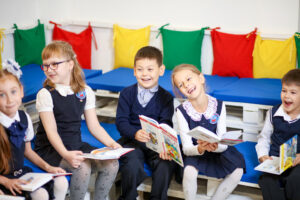
Learning to read is the focus of elementary school. Reading is particularly important for children’s social skills. If the child masters reading and writing, then the whole world of knowledge opens up! The list of sight words for 1st grade is here:
In every learning process, and especially in learning to read, positive motivation plays the decisive role. To encourage and not overwhelm the child, parents and teachers should present new information and knowledge to the child in a didactically coordinated sequence: Always start with simple terms and increase the complexity of the language only slowly. Allow enough time for repetition of what has been learned.
“Repetition is the mother of learning.”
Critical to learning to read is the reader’s ability to comprehend what is being read and to concentrate while reading. Reading comprehension is developed by children first learning and becoming good at various reading techniques: How do I connect letters to form syllables? How do I create a word from syllables? How do I form sentences from words? (and so on)
For children to learn to read and to learn written language easily in school, they need support in early childhood education and list of 1st grade spelling words. Parents and educators should monitor language development and support it with the following:
Pay attention to the child’s oral expression. At age 5, the child needs to communicate with the environment in clear sentences and with correct pronunciation.
Teach the child speech sounds and noises. Speech sounds are those uttered by a person in words; sounds are sounds that may result from a person’s interaction with objects, for example, knocks, footsteps, coughs, creaks, etc.
Introduce the full variety of play forms into the child’s daily routine. Technique games that develop motor skills and visual-spatial awareness; games with rules that lead to rule acceptance; puzzles and coloring with a focus on details and their differences.
Don’t force children to do lessons! Motivate the children to have fun while learning! Give them a list of sight words for 1st grade.
Step 1: At the beginning of learning to read are the sounds
The first step on the road to learning to read is getting to know the sounds: verbal and nonverbal sounds, vowels, semivowels, and voiced or voiceless consonants. For this, eKidz.eu’s free phonics chart is an excellent resource to teach your child the phonetic sounds in a fun way.

Playfully, children learn that letters are used to write down verbal sounds that are heard and pronounced. Try counting the sounds in a word with your child or looking for words that begin with a particular sound. This way, the child is immersed in the world of sounds.
Singing can help children learn to read.
Vowels can be sung. Vowels are sounds in the pronunciation of which the air stream flows freely from the mouth, with no obstruction formed in the oral cavity by the lips, teeth or tongue. To visually clarify the differences between vowels and consonants, explain to the child that vowels live in red “houses” or are marked with red circles/squares.
Consonants cannot be sung. When pronouncing, the airflow encounters an obstruction in the mouth. Build blue “houses” for consonants.
Once you have taught the child the speech sounds, you can now analyze a word acoustically together:
Which sound is the first?
Which is the last or the second?
Count all the sounds in the word!
Then you can introduce the letters: Which letter do we use to spell out which sounds?
From about the age of 5, most children can participate well in phonetic games. Each child develops individually in language as well. Before that, the skills to distinguish the sounds are not fully developed.
Suggested article:The effect of language disorders in learning to read.
Step 2: getting to know the letters
Important for learning to read and write is: letters are written sounds! They form words and thus sentences. To learn to read, the child must not only memorize the graphic design of a letter, but also remember the sounds it denotes. That is, it must learn how the letter is written and how to pronounce it.
Learning the letters: letters are learned one at a time, one at a time. Start with the vowels. Each letter consists of similar graphic elements, therefore the child should not be flooded by a large amount of letters.
It is recommended to introduce the letters step by step and not more than one letter per “learning session” or each time you practice learning to read with your child.
“Games” or learning strategies for your child to learn to read.
When working with a letter, use different learning strategies. Show the letter and name it. Now you can fantasize together with the child:
Ask the child what the letter reminds him or her of.
Model together the shape of the letter and let the child touch the model with closed eyes.
Draw the outline of a letter and give it to the child to color in with colors, strokes, or circles.
Together, reconstruct the letter with toothpicks or the like.
Practice writing the letter together in the air or on sand.
This approach helps to learn the letters more effectively. The child becomes more aware of writing and can more easily build on that foundation later.
I give children the opportunity to try out the spelling of a letter right after it is presented. The letter image is thus better memorized and the first introduction to writing occurs naturally.
Step 3: Learning to read syllables
Next, the child learns to combine letters into syllables. After learning several vowels, the child can continue with consonants. The next big step is usually associated with reading in 1st grade, which is to connect letters into syllables, and then learn to read whole syllables.
It is unnecessary to keep the child too long memorizing the alphabet. The letters are the building blocks for building words, so let the child try them out early.
Connecting the letters and learning to read syllables – by putting them together – is fun!
At first, syllables don’t make much sense to a child: “ua”, “oa”.
It’s best to start with syllables made of two vowels. After that you can continue with closed syllables like “am”, “om”, “ol”. In the next step, read the open syllables: “mo”, “ma”, “la”. Now letters and syllable formation can be learned and practiced at the same time.
Reading syllables is an important skill that helps the child remember and learn the individual letters more easily as well. If the child masters syllable reading, small words can also be read coherently: “mom”, “grandma”, “llama”, “purple”, “soda” and so on.
I recommend focusing children on reading comprehension even at this early stage. To prevent reading from becoming a mechanical reproduction of words, encourage the child to playfully engage with the meaning of what is being read:
Connect the word to a picture.
Bring the pictures and labels out of a jumble and into proper order.
Continue to practice the letters and their graphic features. The writing exercises may now deal with whole syllables and words
Step 4: Learning to read itself (reading words and sentences fluently).
In the transition from syllables to words, the child’s reading speed is slow. It reads in syllables and does not immediately understand the word read. It is very important to invest a lot of time and in no case to push the child to hurry. Over time, it will begin to grasp the meaning of the word from the context more quickly and read familiar words faster and more fluently, and last but not least, learn to read.
Every day the number of known words will increase and the reading speed will increase. At the same time, the pace of learning the alphabet should be maintained and in no case try to speed up the learning process. Remember that each new letter is still very complex for the child and it takes time to learn it.
Now the child can read many words by himself and try to do it faster and faster. When reading quickly, many children learn to guess the word, however, they then often read it incorrectly. If you notice that when reading many word endings are not correct and often whole words are replaced with guessed words, be sure to intervene: reduce the pace of learning, repeat with the child already learned.